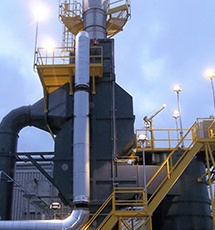In the 1970s a clothing store, SYMS Corporation, debuted a new slogan, "An educated consumer is our best customer." At Catalytic Products, we believe the same is true when it comes to air pollution control equipment.
Every VOC/HAP abatement system is designed around the exhaust stream of the process. Air flow, temperature, and other characteristics are important to determining the best solution for your application. You will also need accurate air flow information when applying for your environmental permits.
When preparing for a volatile organic compound (VOC) abatement project, it is helpful to have the following information:
- Manufacturing Process
- Air Flow
- List of Typical Organics and other
- Environmental Code Requirements
In today’s complex manufacturing practices there are multiple processes involved to create your final product. For example, a company that manufactures automobile brake parts would have a North American Industry Classification System (NAICS) code of 423120. The actual production process that requires Volatile Organic Compounds (VOC) or Hazardous Air Pollutant (HAP) abatement could be coating, which is NAICS code 322220.
An accurate understanding of the air flow, either Standard Cubic Feet Per Minute (SCFM) or Normal Cubic Meter (NM3), is crucial to ensuring the oxidizer is sized correctly. The amount of air flow primarily dictates the size of the oxidizer, which in turn determines the process fan horsepower (HP), the combustion system (gas or electric) requirements and damper and ductwork sizes.
The exhaust stream may come from a single source or from several. So it is important to identify the air flow volume from each source individually and as a whole.
Three key parameters are required to make the necessary calculations:
- Cross sectional area of the duct: Determined by measuring either the total distance around the duct (circumference) and dividing by Pi (π) or by simply measuring the duct diameter.
- Temperature of the gas inside the duct: Determined by inserting a thermometer into the duct and positioning it as close to the center of the air stream as possible.
- Velocity pressure of the gas inside the duct: Determined by inserting a metal rod called a pitot tube into the duct and taking velocity pressure measurements from a handheld instrument called a manometer.
VOC/HAP
Volatile Organic Compound's (VOC’s) vaporize at room temperature. VOC's are the leading cause of ground-level ozone (air pollution, also known as "smog"). In sufficient quantities, VOC's can cause eye, nose, and throat irritations, headaches, dizziness, visual disorders and memory impairment. Some are known to cause cancer in animals and some are suspected of causing cancer in humans. A list of VOC’s can be found on the EPA website: VOC
Hazardous Air Pollutants (HAP’s) also known as toxic air pollutants or air toxins, are pollutants that are known or suspected to cause cancer or other serious health effects, such as reproductive effects or birth defects, or adverse environmental effects. A list of HAP’s can be found on the EPA website: HAPS
To find out what VOC/HAP's are in your exhaust stream, obtain Safety Data Sheets (SDS) (previously known as MSDS) from the person in charge of Production/Manufacturing. You will also need to know the pounds per hour used for each SDS.
Environmental Code Requirements
Air pollution emission permits are typically dictated at both the state and county levels and are administered by a state or local permitting authority. It is important to verify with the local permitting authority what your local requirements are. This will help to ensure you are underneath the threshold levels for your particular region. In most cases, these limits are presented in Tons Per Year (TPY). To determine that value end user would determine the amount of VOC they have in their process on a pound per hour basis and multiply that by the number of production hours in the calendar year.
Although most companies choose to treat the entire plants for VOC emissions, there are cases that some choose to only treat their largest emitters to stay below the threshold level. These cases are rare and typically only happen when there is no plan for expansion or to increase production.
In terms of the capital cost it is always less expensive to purchase a larger air pollution control device to accommodate both the present and future expectations rather than to purchase another entire system down the road.
EPA has several “regions” to control over the country. You can find a list of regions along with their contact information here.

At Catalytic Products International, we work to make sure that our customers have the best solutions to their air pollution remediation needs and that they have the knowledge to continue to meet these needs as they grow and change. For more examples of how our expertise helps our clients find success, please read our Customer Testimonials.









